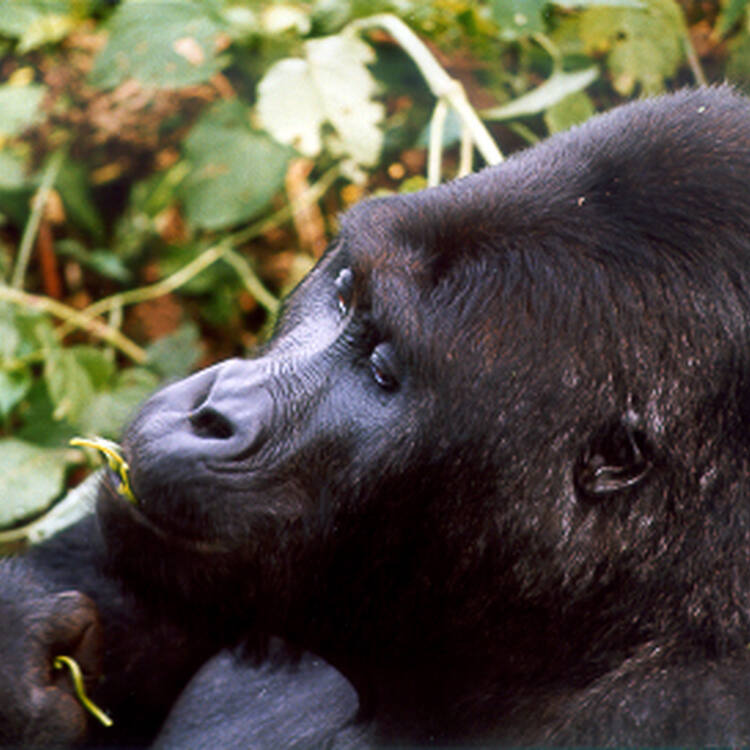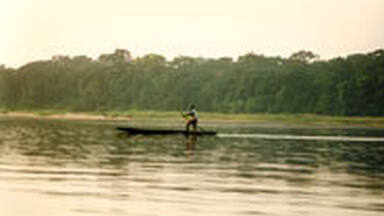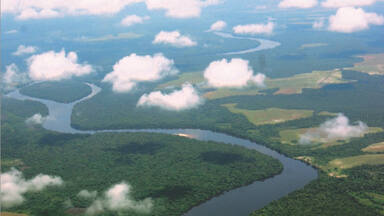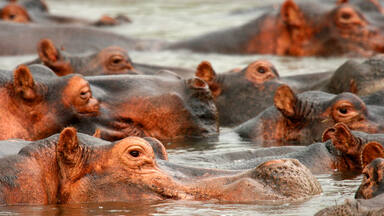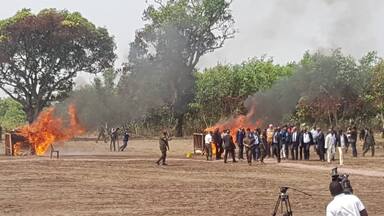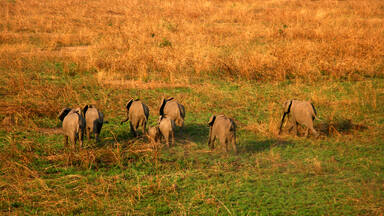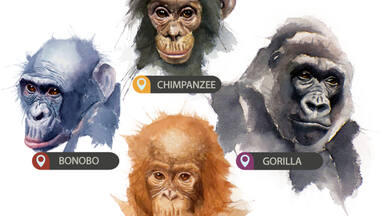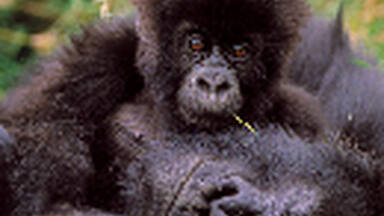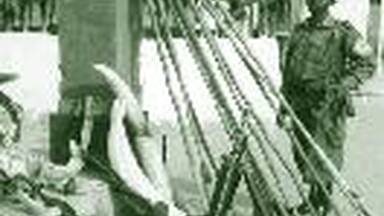Kahuzi-Biega National Park
Kahuzi-Biega National Park
A vast area of primary tropical forest dominated by two spectacular extinct volcanoes, Kahuzi and Biega, the park has a diverse and abundant fauna. One of the last groups of eastern lowland (graueri) gorillas (consisting of only some 250 individuals) lives at between 2,100 and 2,400 m above sea-level.
Description is available under license CC-BY-SA IGO 3.0
Parc national de Kahuzi-Biega
Vaste étendue de forêt tropicale primaire, le parc est dominé par deux volcans éteints spectaculaires, le Kahuzi et le Biega. Il est peuplé d'une faune abondante et variée. Situé entre 2 100 et 2 400 m d'altitude, il y vit l'une des dernières populations de gorilles des plaines de l'est (graueri), qui compte environ 250 individus seulement.
Description is available under license CC-BY-SA IGO 3.0
منتزه كاهوزي بييغا الوطني
يشرف على هذه المساحة الشاسعة من الغابات العذراء بركانان خامدان شاهقان هما بركان كاهوزي وبركان بييغا وتقطنها حيوانات كثيرة ومتنوعة. كما تعيش على ارتفاع يتراوح بين 2100 و2400 متر إحدى تجمعات غوريلا الجبال الأخيرة التي تضم نحو 250 غوريلا ليس إلاّ.
source: UNESCO/CPE
Description is available under license CC-BY-SA IGO 3.0
卡胡兹-别加国家公园
这是卡胡兹和别加两座壮观的死火山雄踞的大片原始热带森林,公园有种类丰富、数量繁多的动物资源。其中最后的山地大猩猩群之一(大约只由250头组成)就生活在海拔2100至2400米之间的地区。
source: UNESCO/CPE
Description is available under license CC-BY-SA IGO 3.0
Национальный парк Кахузи-Биега
Крупные массивы девственных экваториальных лесов, над которыми доминируют два живописных потухших вулкана Кахузи и Биега, дают приют богатой и разнообразной фауне. Одна из последних в мире популяций горной гориллы (примерно 250 животных) обитает на высотах 2100-2400 м.
source: UNESCO/CPE
Description is available under license CC-BY-SA IGO 3.0
Parque nacional de Kahuzi-Biega
Este sitio abarca una vasta extensión de bosque tropical primario, dominada por la cima de dos majestuosos volcanes extintos: el Kahuzi y el Biega. Poblado por una fauna abundante y variada, el parque alberga una de las últimas poblaciones de gorilas de las planicies orientales (graueri), integrada tan sólo por unos 250 especímenes que viven a una altitud de 2.100 a 2.400 metros sobre el nivel del mar.
source: UNESCO/CPE
Description is available under license CC-BY-SA IGO 3.0
カフジ-ビエガ国立公園
コンゴ東部、ルワンダとの国境にあるキヴ湖の西岸一帯。1970年、この地域に生息するヒガシローランドゴリラを守るために、カフジ-ビエガ国立公園が開設された。この結果この広大な熱帯多雨林で生活していたピグミー人が、境界外に強制移住させられ、農耕民化していきました。公園内には沼地や泥炭湿原が果てしなく広がり、豊かな植生も見られる。公園名は二つの高山の名をつなげたものである。source: NFUAJ
Nationaal park Kahuzi-Biega
Dit Nationaal park omvat een uitgestrekt gebied van primair tropisch regenwoud dat wordt gedomineerd door twee spectaculaire vulkanen, Kahuzi (3.308 meter) en Biega (2.790 meter). Het park ligt op het breukvlak van de Albertine rift en het Congobekken en vormt een uitzonderlijke habitat voor de bescherming van het regenwoud en de oostelijke laaglandgorilla's (graueri). Er leeft hier een groep van zo’n 250 graueri, ze vormen een van de laatste groepen oostelijke laaglandgorilla’s. Het gebied is meer dan 600.000 hectare groot en bestaat uit dichte laaglandregenwouden en Afromontane bossen, met bamboebossen, subalpine weiden en heide op de bergen Kahuzi en Biega.
Source: unesco.nl
Outstanding Universal Value
Brief synthesis
Straddling the Albertine Rift and the Congo Basin, Kahuzi-Biega National Park is an exceptional habitat for the protection of the rainforest and the eastern lowland gorillas, Gorilla berengei graueri. Extending over 600,000 ha, are dense lowland rainforests as well as Afro-montane forests, with bamboo forests and some small areas of sub-alpine prairies and heather on Mounts Kahuzi (3,308 m) and Biega (2,790 m).
The Park contains a flora and fauna of exceptional diversity, making it one of the most important sites in the Rift Albertine Valley, it is also one of the ecologically richest regions of Africa and worldwide. In particular, the most important world population of eastern lowland gorillas (or de Grauer), sub-species endemic to the Democratic Republic of the Congo (DRC) and listed under the endangered category on the IUCN Red Data Book, uses the mosaic of habitats found in the property.
Criterion (x): Kahuzi-Biega National Park contains a greater diversity of mammal species than any other site in the Albertine Rift. It is the second most important site of the region for both endemic species and in terms of specific diversity. The Park protects 136 species of mammals, among which the star is the eastern lowland gorilla and thirteen other primates, including threatened species such as the chimpanzee, the colubus bai and cercopiuthic of Hoest and Hamlyn. Other extremely rare species of the eastern forests of the DRC are also found, such as the giant forest genet (Genetta victoriae) and the aquatic genet (Genetta piscivora). Characteristic mammals of the central African forests also live in the Park, such as the bush elephant, bush buffalo, hylochere and bongo.
The property is located in an important endemism zone (Endemic Bird Area) for birds identified by Birdlife International. The Wildlife Conservation Society established a complete list of birds in the Park in 2003 with 349 species, including 42 endemic. Also, the Park was designated as a centre of diversity for plants by IUCN and WWF in 1994, with at least 1,178 inventoried species in the highland zone, although the lowland yet remains to be recorded. The Park is one of the rare sites of sub-Saharan Africa where the floral and fauna transition from low to highlands is observable. In effect, it includes all the stages of forest vegetation from 600 m to more than 2,600 m, dense low and middle altitude rainforests to sub-mountain to mountain and bamboo forests. Above 2,600 m at the summit of Mounts Kahuzi and Biega, a sub-alpine vegetation has developed, with heather, and home to the endemic plant Senecio kahuzicus. The Park also contains plant formations, rare worldwide, such as the swamp and bog altitudes and the marshland and riparian forests on hydromorphic ground at all altitudes.
Integrity
The forests of the property are characterized by continuous vegetation from the summit of the mountains to the lowland regions. A corridor connects a highland zone of 60,000 ha to a lowland sector of 540,000 ha. The area of the property is considered as sufficient to maintain its fauna. Maintenance of the sustainability of the vegetation is essential to avoid the fragmentation of animal populations, in particular the large mammals.
Protection and management requirements
The property is protected by the National Park legal status and managed by the Congolese Institute for Nature Conservation (ICCN). A management and surveillance structure is present. A management plan should be finalized and approved.
Although the greater part of the property is inhabited, some villages were included in the Park at the time of its extension in 1975, creating disputes with the populations. These problems must be resolved to strengthen the effectiveness of conservation actions.
The boundaries of the property should also be clearly delineated, especially where there are no evident natural boundaries. This is particularly important both in the lowlands and the key corridor connecting the high and low biographic regions of the Park.
The highland sector is crossed by a national road with minimal traffic. The control of the traffic flow is important to avoid an impact on the populations of threatened species in this sector, notably the gorillas.
At the time of the inscription of the property in 1980, challenges of protection and management had been highlighted, including the economic problems that have caused a serious reduction in the effectiveness of the management and necessary protection to guarantee the survival of species in the Park and the sustainability of its ecosystems. It was also noted that because of logistical problems large areas of the Park were only rarely observed, even never visited by the under-staffed guards, and poaching has since increased.
Political instability in the region, provoking the displacement of thousands of people, represents a very serious threat to the integrity of the property, resources and populations of large mammals in the Park have declined dramatically. The Park does not have a designated buffer zone, supporting cooperation of the neighbour populations in the conservation of the property is one of the principal tasks of management, in particular in the zones of heavy human density.
Another key challenge is that of the control of poaching and artisanal oil exploration in the former extraction sites. Hunting of wild game for bush meat as well as the conversion of habitats are considered the consequence of the presence of numerous miners in the Park. With the financial and human resources being insufficient, it becomes imperative to obtain additional means to strengthen the effectiveness of management including, ideally, the creation of a Trust Fund.
